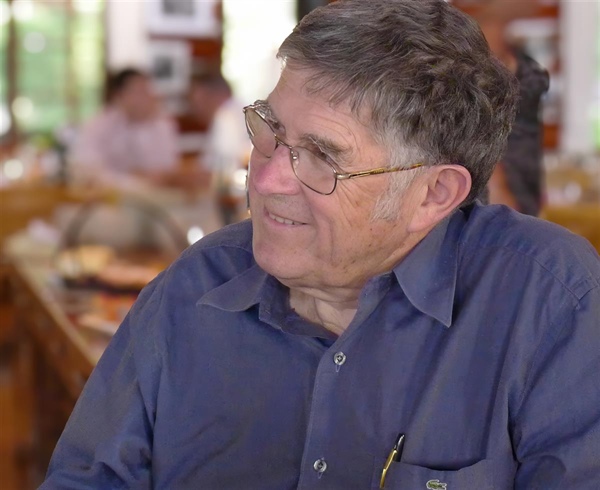
Tribute by Dr. Reinhard Zeller
On May 4th, 2025, at the age of 88, Professor Jean Dubousset passed away in Paris. With his passing, EPOS and many other scientific societies have lost not only an active member but a true legend. He profoundly touched countless lives—mine among them.
Though internationally renowned for transforming the management of scoliosis, Jean Dubousset was also a pioneer in pediatric orthopedics and bone tumor surgery. His contributions in these domains led to numerous innovations.
Jean Dubousset was born in 1936 in the Auvergne region of France—a land of rolling hills, ancient volcanoes, and resilient souls. His father, a sign painter, passed on a deep artistic sensibility to the family. Jean himself became an accomplished painter and creator of stained-glass windows, contributing to the restoration of old churches. His artistic eye enriched his clinical work; he saw what others did not. That rare capacity for observation, combined with a sharp intellect and bold creativity, made him a visionary leader everyone admired.
Jean’s pioneering work sprang from meticulous clinical observation. At a time when medical research leaned heavily on statistical abstraction, he remained faithful to the nuanced, humane art of clinical analysis. One of his guiding principles was: "Your patients are your teachers." Presenting a particularly instructive case, he always remembered the patient by his/her name—a testament to his deep respect for each individual he cared for. His compassionate patient-centered philosophy was the foundation of his practice, not just an occasion to demonstrate his surgical excellence.
Yet he was not a clinician alone. His keen interest in research led to groundbreaking collaborations: with the ENSAM biomechanical lab (Professors Lavaste and Skalli), in exploring melatonin’s role in scoliosis (with Dr. Masafumi Machida, Tokyo), and in the development of a low-dose X-ray system alongside Nobel Laureate Professor Georges Charpak- to name a few.
Jean began his medical training in the late 1950s, when anesthesia was often still administered with an Ombredanne mask. It was during this formative period that he met Anne-Marie, a pioneering anesthesiologist in her own right and his lifelong partner in both life and medicine.
Following residency within the Paris public hospital network (AP-HP), he joined the Pediatric Surgery Division led at that time by Professor Pierre Petit at the historic Saint-Vincent-de-Paul Hospital. There, he would remain for the entirety of his surgical career.
Among his early influences was Dr. Pierre Queneau, whose keen intellect and quiet humility left a lasting impression. Initially drawn to anterior spinal surgery, Jean introduced anterior strut grafting through the concave approach for severe kyphoscoliotic deformities. He would go on to explore the Harrington system, then combine Harrington and Dwyer techniques, and later employ Luque instrumentation for neuromuscular scoliosis.
A defining moment came in 1983 when he partnered with Dr. Yves Cotrel. Together, they developed the CD instrumentation and its principles—revolutionizing spinal surgery worldwide. His career became more and more international. He spent a sabbatical year with Harry Shufflebarger in Miami and later with Tony Herring, Charles Johnston, Steve Richards, and John Birch at the TSRH in Dallas, which fostered lifelong friendships.
In 1991, he was appointed Associate Professor at Université René Descartes (Paris V). From then on, he was a frequent keynote speaker at major international conferences. He preferred the dynamism of lectures over the austerity of the written word, believing deeply in the power of dialogue and intellectual exchange with his colleagues. This led to enduring friendships across the five continents.
Despite his unwavering love for France, he was always open, gracious, and welcoming to all who approached with curiosity and goodwill. To visit Jean and Anne-Marie’s home was to feel genuinely welcomed.
France recognized his exceptional contributions by naming him Chevalier de la Légion d’Honneur and inducting him into the Académie de Médecine. One of his final scholarly pieces—an article on the death of composer Maurice Ravel—reflected his great interest in the arts.
Despite the honors, Jean remained humble. An anecdote highlights his aversion to official honor ceremonies: In 2004, EPOS awarded him the prestigious “Pro Maximis Meritis” Award. He couldn't attend the ceremony due to "urgent family reasons," so I had to deliver his laudation and accept the award on his behalf.
In his final journey, he returned to his native Auvergne. At his funeral in the village he loved, the entire community came to pay tribute—simple, heartfelt, and deeply human. As Prof. Alain Dimeglio observed, it was a ceremony that mirrored Jean’s life: unpretentious, sincere, and profoundly moving.
Jean Dubousset is survived by his beloved wife Anne-Marie, his children Valérie, Pierre, and François, and his grandchildren.
As a kind mentor, a friend to many, and a beacon to generations of surgeons and patients alike, Professor Jean Dubousset will be deeply missed—but his influence endures in every life he touched and every lesson he passed on.
“Au revoir, Monsieur…”